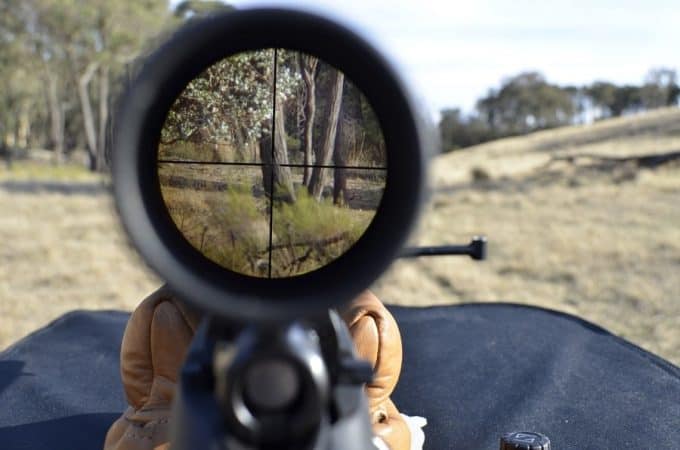Whether shooting for sport, hunting or protection, there’s only one real point of it all, and that’s to launch a projectile and hit your target! Guns are built with the purpose of launching the projectile in the form of a bullet, but actually hitting the target is up to you as the shooter.
Most rifles have an iron sight system built onto them so that you at least have an aiming point, and the rest depends on your aim, focus, and the practice time you put in. But, if you want to be able to shoot a little more accurately, magnify and see your target more clearly, and make those much longer shots, then it’s time you learn how to use a scope.
Some Things You Will Need
Your Rifle – The type of rifle you have will determine the type and style of scope you will need to use, and the different features you want for your scope.
Scope Of Your Choice – You will need a scope that goes with the rifle you are using. Scopes vary in magnification ranges from 1.5x power to 50x power. You want one with the appropriate power range for the maximum distance you will be shooting, and probably specific applications such as hunting, competition shooting, tactical, etc. You will also want to take into consideration the size and weight of the scope, reticle, parallax, adjustments and other such features.
Scope Rings – Scope rings are pretty basic, but even these come in a variety of options to choose from. You want to be sure your scope is mounted at the appropriate height for you. You also need to know whether or not you want special rings like see-through rings or a cantilever mount.
We’ve written another article on measuring ring height that you may find helpful when installing scope rings.
Firing Range – A good, safe range with the distance you need to zero your rifle, or however far out you want to target shoot. This area needs to have an appropriate bullet or backstop, and you need to be sure to have the appropriate safety equipment like earplugs and safety glasses.
Target – Whatever target you choose to shoot at. For zeroing, I would suggest something that has some kind of a bulls-eye on it so you can check that your scope is zeroed properly.
General Setup
Zeroing is your base distance, or starting point, that you might be shooting at. For most hunting, I personally will zero my rifle at 100 yards. You may zero your rifle at 50 yards, or a farther distance like 200 yards depending on what you are planning to use your rifle for and the type of rifle. For this guide, we will set our distance at 100 yards. So, to zero, we want the bullet to hit dead center of the bulls-eye, or close, from a distance of 100 yards away. This is the goal you will be adjusting your scope for.
You want your test area for zeroing to be free from wind and as level as possible. This is a controlled shoot, so you want the conditions to be as close to perfect as possible to make sure your rifle is set accurately.
The scope rings that you mount your scope with should, ideally, be as low to the rifle as possible without touching it. You want this for balance and recoil protection. However, you may have to choose different height scope rings if the shorter ones are not comfortable for you or throw off your shooting.
You don’t want to go overboard on your scope. Good glass is key, but magnification varies so much, and what you really want in magnification is the lowest possible setting where you can see the entire target image clearly at your maximum distance. If you will be shooting out to only 300 yards, then you don’t need a 50x powered scope. A 3x-10x will be just fine. Too much magnification can limit your peripheral sight, cause a shadow effect and make target acquisition harder. It also makes the scope bulky, heavy and more expensive.
How To Use A Scope
Step 1 – Ready
Choose your control range in a safe location with appropriate back-stop and set your target at 100 yards. If you’re ready to shoot, then you have your scope mounted on your rifle with the correct sized rings and are ready to zero. Make sure you have hearing protection and safety glasses on.
Step 2 – Set
Aim, looking through your scope and make sure it’s a comfortable sight and position. Set your magnification low, but to where you can see the entire target image clearly. For the first few shots, you want the magnification lower so if you are very off target, you can get some kind of idea where you are hitting at.
Step 3 – Go
Fire your first two or three shots. Now you can dial-in your scope for the precision you need. Hopefully, you are at least hitting part of the target now, so adjust your windage (left and right) and elevation (up and down) knobs to bring the reticle or aiming point into the center of the bulls-eye.
Fire again. Repeat this process until you are consistently hitting the target where you want. Now adjust your magnification to a bit closer image and make sure you are still hitting on target. Congratulations, you have now zeroed your rifle!
Step 4 – Continue
Now that you are zeroed, you can shoot further distances, or shorter distances, to see how much you need to elevate your rifle to hit most any distance you’re aiming for. The key to getting good at this is to just keep practicing and learning your scope adjustments.
Conclusion
Basically, that’s all there really is to using a scope! Yes, it gets more technical and can be addictive and expensive upping the game, but for the most part, a scope is a mounted monocular, and aids in magnifying your target and assisting you in making that perfect shot. To actually achieve that perfect shot, practice with the scope and keep on shooting!
Looking to really elevate your long range shooting game? You might want to research a rangefinder scope. These optics are not necessarily a new idea, they are one of the most recent developments in the hunting optics space. Expect big things from companies like Vortex, Leupold, and Swarovski in the next few months.
If you enjoyed this article you’ll probably like these:



